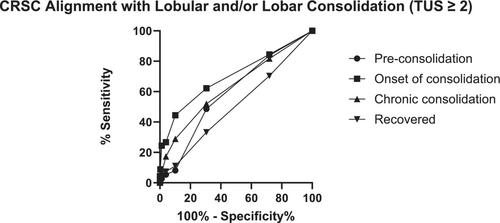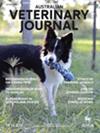Bovine respiratory disease (BRD) has serious impacts on dairy production and animal welfare. It is most commonly diagnosed based on clinical respiratory signs (CRS), but in recent years, thoracic ultrasonography (TUS) has emerged as a diagnostic tool with improved sensitivity and specificity. This study aimed to assess the alignment of BRD diagnoses based on a Clinical Respiratory Scoring Chart (CRSC) and weekly TUS findings throughout the progression of BRD of variable severity in preweaned Holstein dairy heifers.
A total of 60 calves on two farms were followed from the 2nd week of life through the 11th week of life and assessed on a weekly basis for CRS and lung consolidation via TUS. The alignment of BRD diagnoses based on CRSC scores and TUS findings was evaluated across disease progression (pre-consolidation, onset, chronic, or recovered) and severity (lobular or lobar lung consolidation) using receiver operator curves and area under the curves combined with Cohen's kappa (κ), sensitivity, and specificity.
The diagnosis of BRD using CRSC scores ≥5 aligned best with the onset of lobar lung consolidation (>1 cm in width and full thickness). This equated to an acceptable level of discrimination (AUC = 0.76), fair agreement (κ = 0.37), and a sensitivity of 29% and specificity of 99%. Similarly, there was acceptable discrimination (AUC = 0.70) and fair agreement (κ = 0.33) between CRSC ≥5 and the onset of a less severe threshold of disease based on lobular (1–3 cm2 but not full thickness) or lobar consolidation. Discrimination remained acceptable (AUC = 0.71) with fair agreement (κ = 0.28) between CRSC scores ≥2 for nasal discharge and/or cough (spontaneous or induced) and the onset of lobar consolidation. However, sensitivity was <40% across comparisons and outside of the onset of disease there tended to be poor discrimination, slight agreement, and lowered sensitivity between CRS and TUS diagnoses of lobular or lobar consolidation (pre-consolidation, chronic, or recovered). Conversely, specificity was relatively high (≥92%) across comparisons suggesting that CRSC diagnoses indicative of BRD and associated lung consolidation tend to result in few false positive diagnoses and accurate identification of healthy animals.
Although we found the specificity of clinical signs for diagnosing lung consolidation to be ≥92% across all methods of TUS evaluations, the low levels of sensitivity dictate that clinical assessments lead to many false negative diagnoses. Consequently, depending on clinical signs alone to diagnose BRD within populations of dairy calves will likely result in overlooking a substantial proportion of subclinically affected animals that could inform the success of treatment and prevention protocols and guide management decisions.



